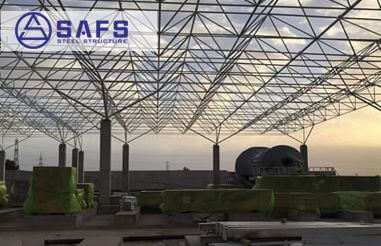In the field of architecture, the space frame steel structure is a common structural form, with the advantages of light weight, high strength, and easy construction. However, the mechanical properties of space frame steel structures at ambient temperature and high temperature are different, so they need to be studied and analyzed in depth. This paper will explore the mechanical analysis of space frame steel structures at ambient temperature and high temperature.

space frame steel structure
- Advantages of space frameSteel Structures
space frame steel structures are three-dimensional space frame structures composed of many members connected by nodes. This structural form has many advantages, including:
- Lightweight: space framesteel structures are made of lightweight steel, which is lighter in weight than other structural forms, reducing the bearing pressure on the foundation.
- High strength: space framesteel structures have high strength and stiffness, able to withstand large loads and pressures.
- Easy construction: space framesteel structures use standardized nodes and members, making installation convenient and reducing the construction period.
- Large space: space framesteel structures have an open spatial structure, meeting the requirements of building use, and can also increase the aesthetics of the building.
- Mechanical Analysis of space frameSteel Structures at Ambient Temperature
At ambient temperature, the mechanical properties of space frame steel structures are mainly affected by axial force, shear force, and bending moment, etc. Below, these forces are analyzed separately:
- Axial force: The axial force is the force that acts along the longitudinal direction of the space framemember. The axial force is transmitted from the support to the member through the nodes.
- Shear force: The shear force is the force that acts perpendicular to the longitudinal direction of the space framemember. The shear force is transmitted from one member to another through the nodes.
- Bending moment: The bending moment is the force that causes the space framemember to bend. The bending moment is transmitted from one member to another through the nodes.
In conclusion, the mechanical analysis of space frame steel structures at ambient temperature and high temperature is important for ensuring the safety and stability of the structure. 1. Axial force: Axial force is the main force in the space frame steel structure, caused by vertical loads and horizontal loads. In the space frame steel structure, the axial force received by the members is mainly determined by the constraints of the nodes and the stiffness of the members.
- Shear force: Shear force is caused by horizontal loads and mainly acts at the nodes of the space frame steel structure. In the space frame steel structure, the nodes are usually welded or bolted together, and their shear resistance is relatively weak. Therefore, in the design, the shear strength of the nodes needs to be considered.
- Bending moment: Bending moment is caused by both vertical loads and horizontal loads and mainly acts on the members of the space frame steel structure. The bending moment received by the members is related to the section shape, size, and node constraints of the members. In the design, the bending strength and stiffness of the members need to be considered.
III. Thermal Analysis of Space Frame Steel Structure at High Temperature
At high temperatures, the mechanical properties of the space frame steel structure will change, mainly manifested in the following aspects:
- Change in material properties: The elastic modulus and yield strength of steel will change at high temperatures. As the temperature rises, the elastic modulus of steel gradually decreases, and the yield strength also gradually decreases. This change will affect the bearing capacity and stability of the space frame steel structure.
- Change in node connection performance: The connection performance of the nodes at high temperatures will be affected. Node connections are usually welded or bolted, and the metals at these connection points may undergo creep and relaxation at high temperatures, leading to a decrease in the constraint force of the nodes. This change will affect the overall stability and load-bearing capacity of the space framesteel structure.
- Changes in structural deformation: The space framesteel structure may deform at high temperatures. Due to uneven temperature distribution, different parts of the structure may undergo different deformations, causing changes in the internal stress distribution of the structure. This change may cause structural damage or accidents. Therefore, the design should consider the deformation and stress distribution of the structure under high temperature conditions.
- Conclusion
This paper analyzes the mechanical properties of space frame steel structures at both ambient and high temperatures. Through the analysis, it can be seen that the mechanical properties of space frame steel structures at ambient temperatures are mainly affected by axial force, shear force, and bending mom
